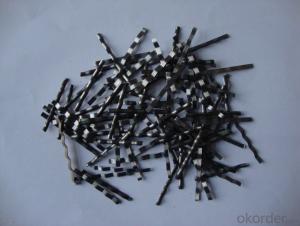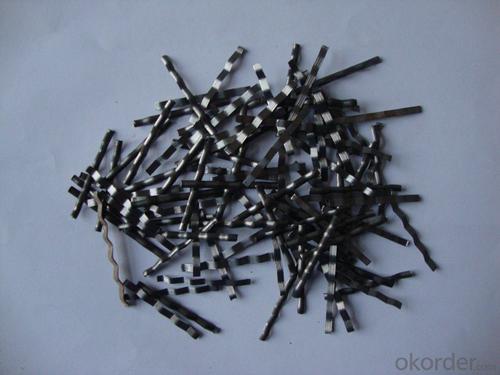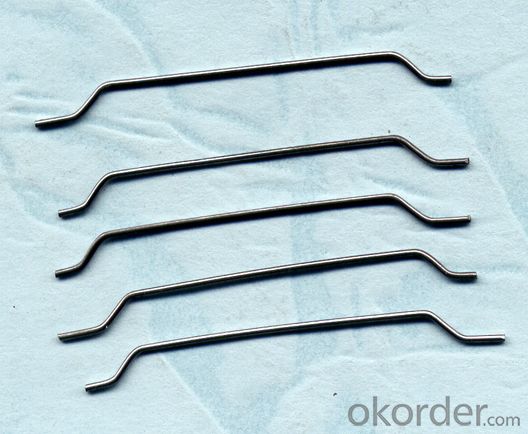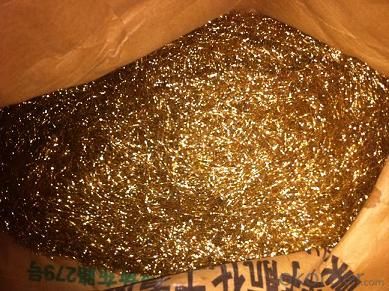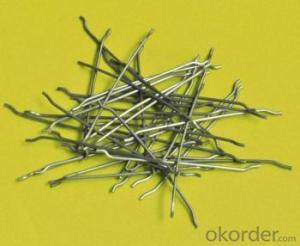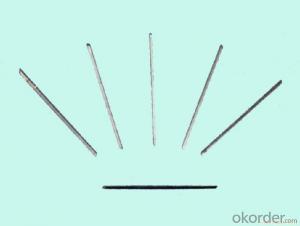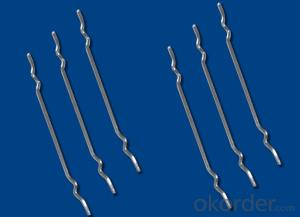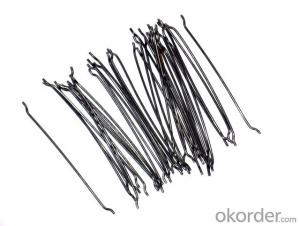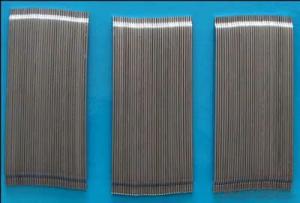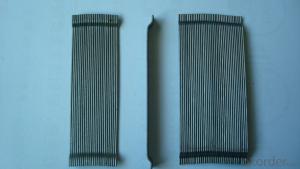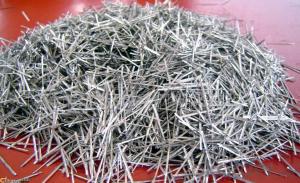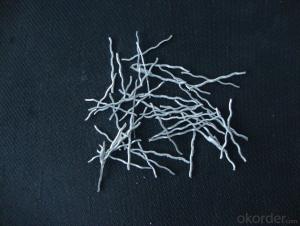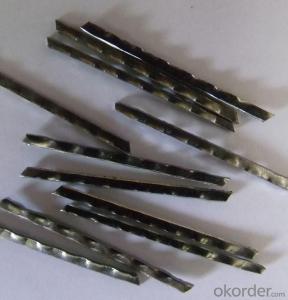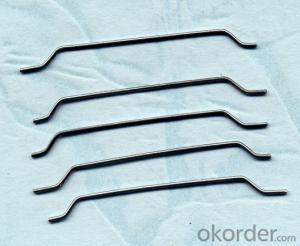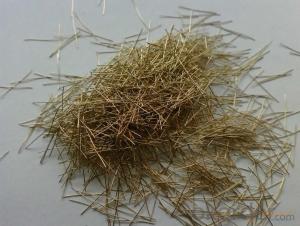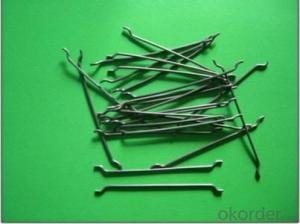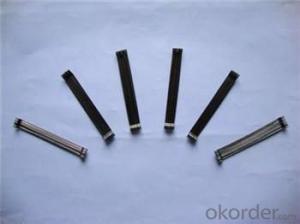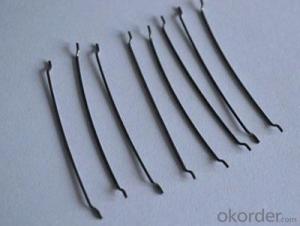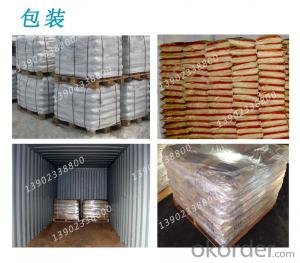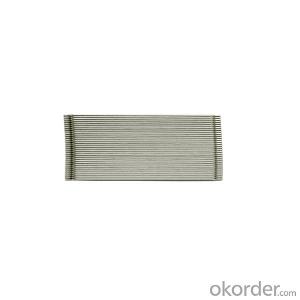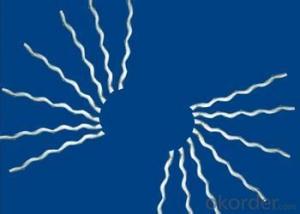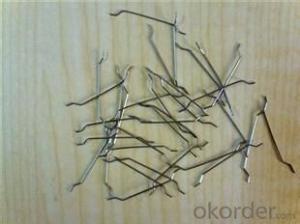Melt Extract Stainless Steel Fiber - Steel Fiber Copper Coated with Wire Diameter
- Loading Port:
- Tianjin
- Payment Terms:
- TT OR LC
- Min Order Qty:
- 1000 kg
- Supply Capability:
- 30000 kg/month
OKorder Service Pledge
OKorder Financial Service
You Might Also Like
Quick Details
Place of Origin: China (Mainland)
Model Number: HT-ST
Material: Steel
The Products
1>steel fiber
2>tensile strength: >1000Mpa
3>wire diameter:0.5mm-1mm
4>standard: ASTM A820
5>20 years factory
Specifications
Comparison of Steel fiber Reinforced Concrete and Ordinary Concrete
Item | Ordinary concrete | Steel fiber reinforced concrete | Enhancement rate |
C30(RC) | C30(SFRC) | (,%,) | |
Tensile strength | 3,5MPa | 5,39-7MPa | 54-100 |
Compressive strength | 31,2MPa | 32,5-40MPa | 4,4-28,2 |
Ultimate bending strength | 5,5MPa | 9,18-13,75MPa | 67-520 |
First crack bending strength | 4,88MPa | 7-8Mpa | 43-100 |
First crack strength | 8,85N,m | 23-53N,m | 160-500 |
Impact and fatigue strength | 5,96/cm2 | 53,3-91/m2 | 8-15 times |
Impermeability grade | P6~p12 | 0,5 ~2,5 times |
Reference for using the steel fiber reinforced concrete
Type of steel fiber reinforced concrete | length/mm | L/D |
For general purpose | 20~60 | 30~80 |
Jet concrete | 20~35 | 30~80 |
Joints of seismic frame | 35~60 | 50~80 |
Railway sleeper | 30~35 | 50~70 |
Layered composite pavement | 30~120 | 60~100 |
Proportion of steel fiber and concrete
Proportion for general projects:
Content of steel fiber | Sand percentage (%) | Water cement ratio | Slump (cm) | Unit amount (kg/m3) | ||||
Steel fiber | Cement | Gravel | Sand | Water | ||||
1—1.2 | 40 | 0.45 | 3—5 | 78 | 400 | 1233 | 819 | 180 |
Content of steel fiber | Sand percentage (%) | Water cement ratio | Slump (cm) | Unit amount (kg/m3) | ||||
Steel fiber | Cement | Gravel | Sand | Water | ||||
1.5—1.8 | 48 | 0.45 | 3—5 | 120 | 450 | 1210 | 1035 | 200 |
Picture
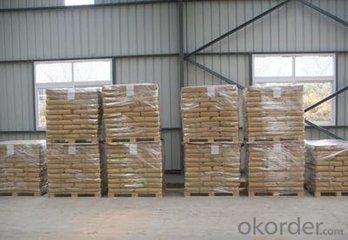
any type
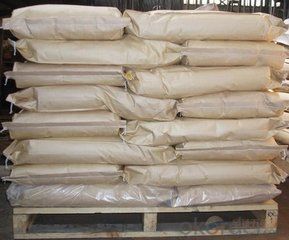
pp bag
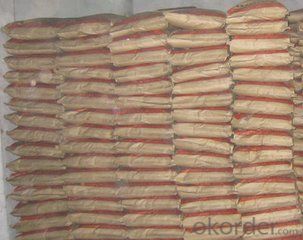
Steel fiber
FAQ
certificated: ISO 9001
Technical advantages of Daye steel fiber:
A. Improve mechanical performance of concrete
B. Provide uniform distribution throughout concrete with excellent mixing
C. No balling or caking by adopt correct mixing method
D. Reduce concrete volume
E.Save construction time and cost
F.Reduce excavation volume
G.Available for jointless floor.
- Q: Can melt extract stainless steel fiber be used in decorative concrete applications?
- Certainly, decorative concrete applications can make use of melt extract stainless steel fiber. This particular fiber variant is meticulously crafted to augment the robustness, longevity, and visual charm of concrete surfaces. By incorporating these stainless steel fibers into the concrete blend, it fortifies the structure and safeguards against cracks and shrinkage. Moreover, the stainless steel fibers have the ability to produce a distinctive visual impact, bestowing a gleaming metallic sheen or texture upon the concrete surface. Hence, it emerges as an ideal preference for decorative concrete applications that prioritize both strength and aesthetics, such as countertops, flooring, and architectural components.
- Q: How does melt extract stainless steel fiber affect the cracking behavior of concrete?
- Melt extract stainless steel fiber has a significant impact on the cracking behavior of concrete. These fibers, which are produced by melting stainless steel and then extracting it into fibers of varying lengths, are commonly used as reinforcement in concrete structures. One of the main benefits of using melt extract stainless steel fiber is its ability to enhance the crack resistance of concrete. When added to the concrete mix, these fibers act as a reinforcement, providing additional strength and preventing the propagation of cracks. This is particularly important in concrete structures that are subjected to heavy loads or dynamic forces, as they are more prone to crack formation. The presence of stainless steel fibers in concrete improves its tensile strength, which is typically much lower than its compressive strength. As a result, the concrete becomes more resistant to cracking, as the fibers help distribute the stress and prevent the formation and propagation of cracks. This enhanced crack resistance is especially beneficial in applications where concrete is subjected to shrinkage, thermal expansion, or external loading, as it helps maintain the integrity and durability of the structure. Moreover, melt extract stainless steel fibers also improve the post-cracking behavior of concrete. In conventional concrete, once a crack forms, it tends to propagate rapidly, compromising the structural integrity and reducing its load-bearing capacity. However, with the addition of stainless steel fibers, these cracks are effectively bridged and restrained, reducing their width and preventing further propagation. This post-cracking behavior is crucial in maintaining the structural performance and serviceability of the concrete under various loading conditions. In summary, melt extract stainless steel fiber significantly influences the cracking behavior of concrete by enhancing its crack resistance, tensile strength, and post-cracking behavior. By reinforcing the concrete matrix, these fibers prevent crack formation and propagation, improving the durability and structural integrity of concrete structures.
- Q: Can melt extract stainless steel fiber be used in lightweight concrete mixtures?
- Certainly, lightweight concrete mixtures can incorporate melt extract stainless steel fiber. To enhance the durability, strength, and crack resistance of concrete, it is common to include stainless steel fibers. These fibers serve as reinforcement, boosting the tensile strength and hindering the development and spread of cracks. By utilizing stainless steel fibers in lightweight concrete, the overall mechanical properties can be enhanced without compromising its lightweight nature. Moreover, the corrosion resistance of stainless steel fibers makes them ideal for enduring applications in concrete structures over an extended period of time.
- Q: How does melt extract stainless steel fiber contribute to the post-cracking behavior of concrete?
- The inclusion of melt extract stainless steel fiber is essential for improving the post-cracking behavior of concrete. These fibers, when added to the concrete mix, create a three-dimensional network within the matrix. This network reinforces the concrete and enhances its overall tensile strength. During the early stages of cracking, the fibers play a crucial role. They distribute the load and prevent the cracks from spreading. By bridging across the cracks, they maintain the structural integrity of the concrete. This is particularly important in situations where the concrete is subjected to dynamic or cyclic loading, as it prevents catastrophic failure. Additionally, melt extract stainless steel fibers significantly increase the ductility and toughness of the concrete. This means that even after cracking, the concrete can still deform without failing. It can absorb more energy before reaching failure. This improved post-cracking behavior allows the concrete to continue carrying loads and performing well, even under severe conditions. Furthermore, the stainless steel fibers also help to reduce the risk of shrinkage cracks in concrete. They restrain the tensile stresses caused by shrinkage, minimizing the formation and propagation of cracks during curing and drying. This is especially beneficial in large concrete structures and environments with varying temperature and moisture conditions. In conclusion, melt extract stainless steel fiber greatly enhances the post-cracking behavior of concrete. It increases tensile strength, bridges cracks, improves ductility, and reduces shrinkage cracking. The inclusion of these fibers ensures that concrete can withstand higher levels of loading, maintain its structural integrity, and exhibit superior performance, even after cracking has occurred.
- Q: Can melt extract stainless steel fiber be used in the construction of power plant structures?
- Yes, melt extract stainless steel fiber can be used in the construction of power plant structures. Stainless steel fibers offer several advantages in construction applications, including their high strength, corrosion resistance, and durability. In power plants, where structures are exposed to high temperatures, extreme pressures, and harsh environments, stainless steel fibers can provide added reinforcement to concrete or other construction materials. Stainless steel fibers help improve the structural integrity of power plant structures by enhancing the concrete's resistance to cracking, spalling, and thermal shock. They can effectively control shrinkage and reduce the formation of cracks, ensuring the longevity and safety of the power plant facilities. Additionally, melt extract stainless steel fibers have excellent thermal conductivity, allowing them to efficiently distribute heat and prevent localized hot spots within the construction materials. This is particularly important in power plants, where excessive heat can cause structural damage and compromise the overall performance of the facility. Moreover, stainless steel fibers are non-magnetic, making them suitable for use in power plants that require non-magnetic materials due to specific equipment or operational requirements. In conclusion, melt extract stainless steel fibers can indeed be utilized in the construction of power plant structures. Their high strength, corrosion resistance, durability, and thermal conductivity make them a valuable addition in ensuring the structural integrity and longevity of power plant facilities.
- Q: Can melt extract stainless steel fiber be used in tunnel lining applications?
- Yes, melt extract stainless steel fiber can be used in tunnel lining applications. Melt extract stainless steel fiber is known for its high tensile strength, corrosion resistance, and durability, making it an ideal material for reinforcing tunnel linings. It can effectively enhance the structural integrity and stability of the tunnel, improving its resistance to cracking, spalling, and other forms of damage. Additionally, stainless steel fibers can also provide excellent fire resistance properties, which is crucial in tunnel environments. Overall, melt extract stainless steel fiber is a suitable choice for tunnel lining applications due to its robustness and ability to withstand the challenging conditions that tunnels often face.
- Q: What are the advantages of using melt extract stainless steel fiber in concrete?
- There are several advantages to using melt extract stainless steel fiber in concrete. To begin with, the durability and longevity of concrete structures are enhanced by stainless steel fiber. The properties of stainless steel that resist corrosion prevent rusting, even in harsh environments. This ensures that the structural integrity of the concrete remains intact over time, making it perfect for use in coastal or industrial areas where exposure to saltwater or chemicals is common. In addition, the tensile strength and crack resistance of concrete are improved by stainless steel fiber. Acting as reinforcement, the fibers distribute stresses and prevent cracks from forming and spreading. This leads to a more robust and durable concrete, reducing the need for expensive repairs or replacements. Furthermore, the impact and abrasion resistance of concrete are enhanced by stainless steel fiber. Acting as a barrier, the fibers absorb and dissipate energy upon impact, reducing the likelihood of surface damage. This makes it suitable for high-traffic areas like roads, bridges, and industrial floors, where wear and tear are major concerns. Moreover, the fire resistance of concrete can be improved by stainless steel fiber. The high melting point of stainless steel (typically above 1300°C) creates a barrier against heat transfer, slowing down the spread of fire and protecting the underlying structure. This is crucial in applications where fire safety is a priority, such as tunnels, parking garages, or buildings. Lastly, the use of stainless steel fiber in concrete allows for design flexibility. The fibers can be easily mixed into the concrete, enabling the creation of complex shapes and forms. This opens up opportunities for innovative architectural designs and structural solutions. In conclusion, melt extract stainless steel fiber provides advantages such as increased durability, enhanced tensile strength, improved impact and abrasion resistance, heightened fire resistance, and design flexibility when used in concrete. These benefits make it a valuable addition to concrete mixtures, ensuring the longevity and performance of concrete structures in various applications.
- Q: What is the effect of melt extract stainless steel fiber on the corrosion resistance of concrete?
- The addition of melt extract stainless steel fiber to concrete can significantly enhance its corrosion resistance. Stainless steel fibers are made from a corrosion-resistant alloy, typically containing chromium, nickel, and other elements. When incorporated into concrete, these fibers create a three-dimensional reinforcement system that helps to mitigate the effects of corrosion. Concrete is susceptible to corrosion when exposed to harsh environments, such as chloride-rich or acidic conditions. These corrosive agents can penetrate the concrete and attack the reinforcing steel, leading to structural deterioration and reduced service life. However, the presence of stainless steel fibers in the concrete matrix acts as a barrier, preventing the ingress of corrosive agents and reducing the risk of corrosion. The high corrosion resistance of stainless steel fibers ensures that they remain intact and effective for an extended period. Unlike traditional steel reinforcements, stainless steel fibers do not corrode easily, even under aggressive conditions. This property helps to maintain the integrity of the concrete, providing long-term durability and reducing the need for costly repairs or replacements. Furthermore, the addition of stainless steel fibers also improves the mechanical properties of concrete, such as its tensile strength and crack resistance. This additional reinforcement helps to prevent the formation and propagation of cracks, which can act as pathways for corrosive agents to reach the reinforcing steel. In summary, the incorporation of melt extract stainless steel fiber in concrete enhances its corrosion resistance by acting as a barrier against corrosive agents and improving the overall durability of the structure. This results in a longer service life and reduced maintenance costs for concrete structures exposed to corrosive environments.
- Q: How does melt extract stainless steel fiber improve the resistance to rutting in asphalt mixtures?
- The resistance to rutting in asphalt mixtures is improved by the presence of melt extract stainless steel fiber, which operates through various key mechanisms. Firstly, the tensile strength and toughness of the asphalt mixture are enhanced by the addition of stainless steel fibers. This increase in strength and toughness aids in the even distribution of the load across the surface of the pavement, thereby reducing the likelihood of rutting. Secondly, the stainless steel fibers function as reinforcement within the asphalt mix, preventing the formation and propagation of cracks. By doing so, these fibers preserve the integrity and stability of the asphalt pavement, effectively preventing the formation of ruts. Moreover, the inclusion of stainless steel fibers in the asphalt mix also boosts its resistance to deformation and the ability to recover from deformation. These fibers provide additional support and resistance against repeated loading and heavy traffic, ultimately reducing permanent deformation and rutting. Furthermore, the presence of stainless steel fibers enhances the resistance of the asphalt pavement to moisture-induced damage. They serve to hinder the penetration of water into the pavement, thus minimizing the risk of moisture-related distresses such as rutting. In summary, the utilization of melt extract stainless steel fiber in asphalt mixtures improves the resistance to rutting by enhancing the tensile strength, toughness, crack resistance, deformation resistance, and moisture resistance of the pavement. This results in a more robust and long-lasting pavement surface that can withstand heavy traffic loads without succumbing to rutting.
- Q: How does melt extract stainless steel fiber improve the flexural toughness of concrete?
- Melt extract stainless steel fiber improves the flexural toughness of concrete through its unique properties and characteristics. When added to the concrete mix, these fibers disperse throughout the mixture, creating a three-dimensional reinforcement network. This network enhances the concrete's ability to resist cracking and increase its overall flexural toughness. The main reason behind this improvement is the high tensile strength of stainless steel fibers. These fibers have an exceptionally high strength-to-weight ratio, which means they can withstand significant tension without breaking. When concrete is subjected to flexural stresses, such as bending or stretching, the steel fibers act as tiny reinforcements, distributing the load and preventing the formation and propagation of cracks. Additionally, the melt extract stainless steel fibers also improve the ductility of concrete. Ductility refers to the material's ability to deform without fracturing. By incorporating steel fibers, the concrete gains enhanced ductility, allowing it to absorb more energy before failure. This characteristic is crucial in applications where the concrete needs to withstand dynamic loading, such as seismic events or impact loads. Furthermore, the unique geometry of the melt extract stainless steel fibers plays a role in improving flexural toughness. These fibers are typically short and randomly oriented, creating a more uniform distribution within the concrete matrix. This random orientation helps to prevent crack propagation by effectively bridging the cracks that may form under bending or flexural stresses. In summary, melt extract stainless steel fiber enhances the flexural toughness of concrete by providing high tensile strength, improving ductility, and creating a three-dimensional reinforcement network. By resisting crack formation and propagation, these fibers significantly increase the concrete's ability to withstand flexural stresses, resulting in a more durable and robust material.
Send your message to us
Melt Extract Stainless Steel Fiber - Steel Fiber Copper Coated with Wire Diameter
- Loading Port:
- Tianjin
- Payment Terms:
- TT OR LC
- Min Order Qty:
- 1000 kg
- Supply Capability:
- 30000 kg/month
OKorder Service Pledge
OKorder Financial Service
Similar products
Hot products
Hot Searches
Related keywords
